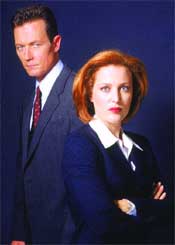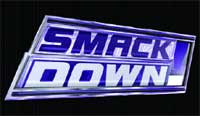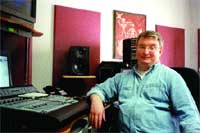 |
|
West Productions often uses organic audio on The X-Files, processing it to take on a paranormal feel. |
Can you imagine a David Letterman "Top Ten" list of the things audio post professionals hear while working on television shows of all types: 10) Need it sooner, 9) need it cheaper, 8) need it better… well, you get the idea. Rather than bucking those trends, today's mixers, editors and supervising sound editors are looking for solutions by turning to faster technology and personnel that are more efficient.
Tom deGorter, who is the supervising sound editor on Alias at Todd/Soundelux in Hollywood, says the fun is in the challenge. "In this case it's fun because of the hurry-up rush while also maintaining that level of quality and that level of creativity," he reports. All the while deGorter has to keep his ear, as it were, on what's important when it comes to audio post for television. "That is such a hard call because I think it's the total package," he explains. "You can't really isolate one small bit. It's incredible the amount of work that goes into a show, and you can't say it's just the music or it's just the effects or just the dialogue; it has to be a cohesive blend of all of them."
Dave West of Burbank's West Productions points out that a successful show, audio post-wise, is not just a handful of people. "Everything I do is a concerted effort by a group of individuals," he says. "When you look at the big picture, that individual thing is 300 to 400 people, from the crew, to the production end to the post production end. So, at my facility, the way I make these things happen is to start at the very beginning and do it right."
With that in mind, Post asked a handful of audio post pros about some of the challenges they've faced, how they've found solutions, tips for the rest of us and what truisms they've discovered.
West Productions Faces X-traordinary Challenges
The West Productions (www.westprod.com) team in Burbank, CA, has been posting The X-Files, now in its final season, since the show started airing on Fox, which has given them the opportunity to create a bevy of interesting soundscapes and environments. The company's CEO, Dave West, reports that in general there's one challenge facing audio post houses right now: "To do the impossible in an incredibly short period of time for nothing," he says. "The X-Files has been a blessing in that it's given us a little more freedom in getting it done and giving it some time, but in today's environment the most difficult problem with all of this stuff is getting it done based on the picture not being ready or the events surrounding the script or the show not being completely done before you have to go on air."
Challenge and Solution: "Every show is especially challenging on The X-Files," West says. An episode that sticks out in his mind was one of the first ones they posted for this season with Lucy Lawless. "It really came out of the gate as a big expectation," he reports. "This is a year that everybody wanted to do their best on." For one show, West and company had to come up with an environment where people had to spend a lot of time underwater. "We wanted to go with a new sound and come up with a better way of doing it. We went through a variety of different audio tracks and ways of manipulating it to come up with this environment that made the super soldiers able to survive underwater," he says. To find a solution they turned to an array of sound effects, organic sounds and ambiences that were pitched beyond recognition. West used tools such as the AMS Neve Logic 7 console, a TC6000 box and Eventide Orville to get the sounds just right and allow him to put a thumbprint on sound. "I've always tried to come up with a texture to our tracks that kind of says, 'Hey, this guy did this.' You like it or I hate it and I think every sound studio and mixer has a style, and if you can make your style noticeable, all the better."
 |
|
Warner Bros. Studios' Todd Grace posts a number of top shows using Pro Tools. On Malcolm in the Middle the challenge is the number of tracks per episode. |
Tip: "I really enjoy taking organic audio and playing it backwards or processing it in such a way that it becomes something else," reports West. "That, stylistically, is the way that I overcome a lot of my obstacles when people need to have a familiar sound that becomes something else. My tip is to start backwards and start slowing it down. I think in a lot of cases, for the spooky environments that we need to create, the tension that we look to build, there's nothing better than taking some animal and slowing it down and running it backwards and have that spook up your track."
Truism: "I think, with what we do, we will always be presented with problems, and great people can usually fix the problem with or without technology. Now that we have technology, it makes it even easier for us to come up with really remarkable audio tracks. There really is a huge advance in what people can hear at home and in the theatre, and I think we've got George Lucas to thank for 99 percent of that."
Wrestling WWF's SMACKDOWN
Stanford, CT-based WWF post mixer and sound designer Chris Argento works in an extremely high pressure situation: he posts the two-hour show Smackdown, as well as a handful of packages, promos and spots for the WWF. The show is taped on Tuesday nights and is completely posted for air on Thursday nights, 52 weeks a year. "We turn out nine hours of programming a week," he says.
Challenge & Solution: With such tight turn-around schedules, Argento has to work swiftly and efficiently. He does a lot of crowd sweetening for shots that are added from backstage tape or for times where the crowd didn't react as desired. "Or sometimes we're dealing with stuff that has to come out in terms of occasional people screaming things in the audience that shouldn't be on the air," he adds with a laugh. "Go figure." They'll also add in sound effects when someone is hit by a chair or some equally exciting WWF experience. "I have a library that I've made up over the years of specific sounds that I use whether it be chair shots or people falling down or people getting hit or punched, or crowds reacting in any way you can imagine," he says. "We use some original music that comes from in-house, but most of the music is flown into the shows live. I do a lot of music editing for the packaged portions, mostly from library music and occasionally not." Argento's solution is to work with a digital console, specifically the Euphonix System 5. The console's recallability, automation and snapshots are the key. "It's made my life much easier," he says.
Tip: Finding the right technology is one of the most important tips Argento feels he can offer. Along with the Euphonix System 5, he uses a Fairlight 48-track and always has a sampler handy. "I'm now turning out 50 percent more work than I was a year before I was working on this stuff," he reports.
Truism: "Audio is always the last thing on the list and you never have enough time to do things the way you want or explore things as much as you want to, at least in my world."
Warner Bros.
Todd Grace, mixer at Warner Bros. Studios (www.wbpostproduction.warnerbros.com, has his hands in a long list of television shows, including The Bernie Mac Show, That '70s Show, Will & Grace and Malcolm in the Middle. Each show presents its own set of challenges that keeps Grace on his toes.
Challenge: Malcolm in the Middle, as Grace explains it, is a single-camera show that is a larger scope than the typical sitcom where the dialogue is built out via full ADR, Foley and sound effects for every show. Often there are over 100 tracks. "The challenge in a show like Malcolm comes from the number of tracks per episode," Grace explains, "and the fact that much of the show is shot on location."
Challenge: On the other hand, That '70s Show is a more traditional multi-camera sitcom that is shot in front of a live audience. The challenge for Grace is the turnaround. "Generally, we have to mix the show and play it back for the client within four hours," he explains. "Adding to this challenge is the fact that the sound editorial process for a sitcom is also abbreviated. Typically, a single sound editor cuts sound effects, music and whatever dialogue fixes possible in the course of one editorial session. This means there is often clean-up work for my recordist and myself to do during the mix." Another issue, especially for a multi-camera show, is working with dialogue that comes with on-set noises and equipment buzzes.
Solutions: Grace turns to a Pro Tools ProControl to handle all of his sound effects and pre-dubs. ProControl then goes into his main console, an SSL 8000 G Plus. "For dialogue processing I use a variety of tools. For notching offensive frequencies I use Yamaha's YDF 2006 dip filter. For eliminating background noise, I use Dolby CAT430s."
Tip: "Never take your work too personally. It's easy to think of a project as 'my mix' or 'my show.' In reality, it is the producer's show and it is our job to give them what they want."
Truism: "It's important to strike a balance between the client and the work. If you can focus on what the client is asking for and translate that into what you know about audio, you usually can get where you need to be."
Georgetown Post Chases Giant For Discovery
 |
|
Smackdown is just one of the challenging shows Chris Argento mixes on the WWF's Euphonix System 5 console. |
Karl Kalbaugh, mixer/sound designer at Washington, DC's Georgetown Post (www.georgetownpost.com), recently completed a one-hour documentary for The Discovery Channel called Chasing the Giant. "We called it the Calamari Safari," he says with a laugh. "It's a one-hour original that was an expedition to find the giant squid."
Challenge and Solution: "The show was a challenge because the main character was filmed on a large research ship that had no consideration toward acoustics," Kalbaugh explains. At times, the announcer would be in the scientific lab that was next to the engine room or he would be on deck with the ocean and crashing waves. To solve those problems Kalbaugh made heavy use of EQ and Digidesign Pro Tools 5.1.3 processing. "Personally, I felt like I did a pretty dang good job of that," he says. "The Pro Tools was completely up to the challenge. A year ago, I would have mixed this on an AMS Neve Libra Post, but instead I mixed it on a ProControl system."
Kalbaugh used Focusrite d2 EQs and the DigiRack compressor, along with the Digidesign Maxim limiter. "That came in and basically saved my life on a number of occasions because noise floors were so high and dialogue was so low," he explains. "I came out with a very solid mix and the folks at [Discovery] were very pleased."
Tip: Kalbaugh says, "Things are going to go wrong and you deal with 'em as best you can and as professionally as you can, but it's still going to happen. The mark of a good mixer is how well you deal with bad sound from the field or trying to get that dialogue out on top along with an effects bed with an orchestral score."
Truism: "Every experience I've ever had mixing documentaries has been driven by the producer's and director's personalities, and you have to be flexible."
Working With women that kick
In Hollywood, Tom deGorter, Soundelux's supervising sound editor for the new hit show Alias, also faces an intense time constraint issue. "We always seem to get a crunch from the time we get the show to when we mix the show," he says. "So, we're cramming and putting all this effort into a short amount of time." According to deGorter, the way the show gets done in such a short period of time is due to the Soundelux (www.soundelux. com) staff. "We get along well together," he states.
Challenge and Solution: Alias is an action show that is driven by music, deGorter explains. "So, we have to figure out what kind of sound effects are going to work with the music without either one overpowering the other and trying to find something that we can poke through. If you cut a ton of stuff that basically gets washed out because of the music, that's not a good thing. We do that on a weekly basis, we always seem to cut with music in mind." deGorter pulls that off by having good taste and trusting his editors. "The whole crew, from the editorial to the mixing, has this really great working relationship. When we go to the mix stage, we check the egos at the door and everybody has a good time. Nobody is afraid to step on each other's toes, and we all have a lot of input. The end result is a much better product that way."
Tip: According to deGorter, "It's crucial to have people around you trust. The way television is now, with the complexity, isn't the way it was 10 years ago. The directors want it to sound more like features. If you only have five days to prepare a show, versus three months and sometimes more on a feature, you have to be able to trust your editors. Obviously, at the end you review things and you discuss things with them, but you have to have a trust."
Truism: "One of the truisms that I liked was: one hears the music from the tune of sounds, and I like to apply that to our way of effects, too. Since it is a music-driven show with a lot of action, we have to be able to cut the sounds that are going to be cohesive with the music."
Buffy's Battles
 |
|
Georgetown Post's Karl Kalbaugh made heavy use of EQ and Digidesign Pro Tools 5.1.3 processing on a recent Discovery Channel program about a giant squid. |
On a weekly basis, supervising Todd/Soundelux sound editor Cindy Rabideau finds herself designing sound for whichever monsters or demons happen to be on Buffy the Vampire Slayer.
Challenge and Solution: "We have to make them sound somewhat different than the week before," Rabideau says of the show's dark guest stars. To make that happen the team will record vocals in different styles and go through a library of animal sounds. "One monster could have up to six different elements to create its vocal," she reports. To blend those sounds, Rabideau turns to Pro Tools with a lot of plug-ins, Sound Designer 2 and an Emulator, though she hasn't found a consistent formula. "It's always a variety of combinations," she says. "Being over here at Todd West, we do a lot of creating on the show. We don't use a lot of canned effects or library effects. We'll go and we'll create stuff with Foley and then bring it into Pro Tools."
There are a few signature sound effects the show uses, but they try to stay away from the typical CD library for a simple reason. "A lot of things are on a sound effects library that every studio has and you can hear it on the TV," she says. "Especially with the digital systems now, it's very easy to go in and load CDs and pull sounds."
Tip: Rabideau believes that finding the right technology is the most important tip she can offer. "Right now the Pro Tools is by far the most useful system [for us]," she says. "It's the most user-friendly and it's the most convenient. With all the plug-ins you can pretty much do anything." Of course, it's crucial to have good people around, "especially for the tight schedules. There's no learning curve."
Truism: "Every opinion is a subjective opinion," Rabideau says with a laugh. "It's a very subjective field."